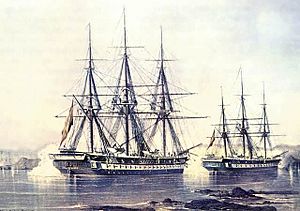Battle of Abtao facts for kids
Quick facts for kids Battle of Abtao |
|||||||
|---|---|---|---|---|---|---|---|
| Part of Chincha Islands War | |||||||
 Spanish screw frigates Blanca and Villa de Madrid during battle, by Federico Castellón Martínez. Naval Museum of Madrid |
|||||||
|
|||||||
| Belligerents | |||||||
| Commanders and leaders | |||||||
| Strength | |||||||
| 2 frigates | 1 frigate 2 corvettes 1 schooner |
||||||
| Casualties and losses | |||||||
| 6 wounded | 2 to 12 killed, 1 to about 20 wounded | ||||||
The Battle of Abtao was a sea battle that happened on February 7, 1866. It was part of the Chincha Islands War. The battle was fought between ships from Spain and a combined fleet from Peru and Chile. It took place near the island of Abtao in the Gulf of Ancud, close to the Chiloé Archipelago in southern Chile. The fighting mostly involved ships shooting at each other from far away. The Peruvian and Chilean ships were safe behind the island because the water was too shallow for the bigger Spanish ships. However, the Spanish ships were better at aiming and hit the Peruvian and Chilean ships.
Contents
What Led to the Battle?
The Peruvian president, Mariano Ignacio Prado, brought together countries in South America to defend against Spain. He sent the allied ships from Ancud to Abtao Island. They went there to wait for two new Peruvian warships called corvettes.
The Spanish commander, Casto Méndez Núñez, found out where the Peruvian-Chilean ships were. He ordered two large Spanish ships, the Villa de Madrid and the Reina Blanca, to go to Abtao. Their mission was to stop the enemy fleet.
On January 16, 1866, the combined Peruvian-Chilean fleet left the port of Ancud. It included the Peruvian ships Apurímac and Amazonas, and the Chilean ship Covadonga. They sailed to the shipyards on Abtao Island. The Chileans had also built some forts on Abtao Island. These forts were in a good spot at the end of a shallow and tricky channel.
During the trip, the Peruvian ship Amazonas hit a hidden rock and sank. The other allied ships arrived safely at Abtao. They waited for the Peruvian corvettes Unión and América. These ships arrived on February 4, 1866, without the Spanish knowing. The Spanish then learned about the other ships near Abtao and sailed there right away.
Ships in the Battle
Spanish Ships
| Name | Type | Cannons |
|---|---|---|
| Villa de Madrid | Frigate | 44 cannons |
| Reina Blanca | Frigate | 39 cannons |
Allied Ships (Peru and Chile)
| Country | Name | Type | Cannons |
|---|---|---|---|
| Perú | Apurímac | Frigate | 30 cannons |
| Unión | Corvette | 14 cannons | |
| América | Corvette | 14 cannons | |
| Chile | Covadonga | Schooner | 5 cannons |
The Battle Begins
On February 7, 1866, the Spanish ships Villa de Madrid and Reina Blanca arrived near Abtao. They did not enter the inlet because they were afraid of the shallow water.
Manuel Villar, the commander of the allied fleet, ordered his ships to attack. The allied ships, including Apurímac, América, Unión, and Covadonga, lined up. They aimed their cannons to cover both sides of the channel.
The allied fleet started firing at 3:30 PM from about 1,500 meters away. The Spanish ships fired back. Even though the two Spanish ships had to shoot one after another, their aim was very good. The Apurímac was hit three times near the water line. This forced her to move away. The América was hit six times. The Unión was hit three times, and two crew members died. The Covadonga was hit once. The Spanish ships were hit 14 times, mostly by the América and Unión. These hits caused little damage, and only 6 Spanish crew members were hurt.
After two hours of fighting, both sides had fired over 1,500 shots. The Spanish ships saw that the allied fleet was well protected by the shallow waters. They decided to leave the area. The Spanish ships returned to their base the next morning.
The Spanish Captain Claudio Alvar González later wrote that the most accurate shots came from the Peruvian corvettes Unión and América.
What Happened After?
After the Battle of Abtao, Admiral Casto Méndez Núñez of Spain tried to find the allied fleet again. He sailed south with more ships, but he could not find them. The allied fleet had moved to Huito, a place even harder to reach than Abtao.
On March 25, the Peruvian corvettes Unión and América were sent to the Strait of Magellan. They were looking for a Spanish ship called Almansa, which was coming from Spain to help the Spanish fleet. The Peruvian ships stayed there for over a month but did not find it. The Almansa did not reach the Pacific coast until late April. Chile also sent a ship, the Maipú, to the strait to look for other Spanish ships.
The rest of the allied fleet stayed in southern Chile. They waited for two powerful ironclad ships, the Huáscar and Independencia, to arrive. These ships would change the balance of power. They had left France on February 26 for a long and difficult journey.
Famous Sailors in the Battle
Some sailors who became very famous later on took part in this battle.
- Sub-lieutenant Patricio Montojo y Pasarón was on the Spanish frigate Almansa. He later became an admiral and led the Spanish Navy in the Philippines during the Spanish–American War.
- Lieutenants Arturo Prat (from Chile) and Miguel Grau (from Peru) were comrades in this battle. They later fought against each other in the famous Naval Battle of Iquique.
See also


